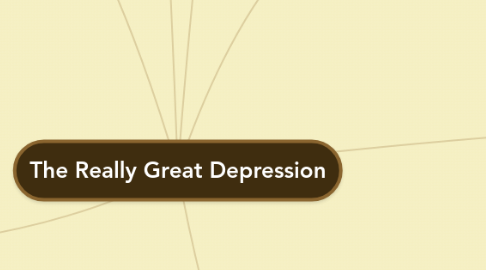
1. Buying on Credit
1.1. Is a promise to make payment at a later time
1.1.1. Many jumped at the opportunity to buy as many things as they wanted
1.1.1.1. Issues came because people could not repay the amount used
1.1.2. Was introduced as a way to purchase goods
1.1.2.1. Will generally include interest as well
1.1.3. Essentially treated as money, yet not actual money
2. Technological Changes
2.1. The Roaring 20's / Pre-Depression
2.1.1. First Mass Production of Cars (1913)
2.1.1.1. Henry Ford
2.1.2. Widespread Usage of Radio
2.1.2.1. Crystal Sets
2.1.2.2. Vacuum Tubes
2.1.2.3. Dynamic Loudspeaker (1924)
2.1.2.4. Car Radio (1929)
2.1.3. Television and Film
2.1.3.1. First 3-D Movie (1922)
2.1.3.2. Iconoscope (First Tv) (1923)
2.1.3.3. Mechanical Television (1925)
2.1.3.4. Technicolor (1927)
2.1.3.5. Electronic Tv Set (1927)
2.1.4. Medical Inventions
2.1.4.1. Insulin by Sir Fredrick Grant Banting(1922)
2.1.4.2. Iron Lung (1927)
2.1.4.3. Penicillin By Alexander Fleming (1928)
2.1.5. Everyday Life and Others
2.1.5.1. Tommy Gun (1920)
2.1.5.2. Band-Aid (1920)
2.1.5.3. Artificial Life/Robot (1921)
2.1.5.4. Lie Detector (1921)
2.1.5.5. Frozen Food (1923)
2.1.5.6. Traffic Signal (1923)
2.1.5.7. Aerosol Can (1927)
2.1.5.8. Electric Shaver (1928)
2.1.5.9. Scotch Tape (1930)
3. Overproduction
3.1. Many people had jobs producing goods
3.1.1. Carpenter
3.1.2. Metal Workers
3.1.3. A big fraction of these people loss their jobs when the effects of overproduction began
3.1.4. Tailors
3.1.5. Appliance Makers
3.2. Many goods were made, produced and leftovers stored
3.2.1. Everyone bought lots of products
3.2.1.1. However, factories overproduced & began having an inventory of goods they couldn't sell causing an unsteady markey
3.2.1.1.1. Many factories had to let go of workers making them unemployed and without money.
3.2.1.1.2. People could only have so much of a luxury and unemployed/poor citizens could not buy the excess goods they had in store.
3.2.1.2. Houses were being connected with electricity meaning people could buy electronic appliances.
4. Overdependance on the USA
4.1. American Stock Market Crash
4.1.1. Prices of base commodities drop by over 50%
4.1.1.1. Wheat
4.1.1.2. Lumber
4.1.1.3. Paper
4.1.1.4. Different Minerals
4.1.2. High Trade Tariffs by the US put in Place
4.1.2.1. Smoot–Hawley Tariff Act in 1930
4.1.2.1.1. In response Canada increases its own tariffs and starts trading with Britain more
4.2. 65% percent of imports were from the US
4.3. 45% percent of exports from the US
5. Government Responses To Economic Decisions
5.1. Calvin Coolidge
5.1.1. Coolidge was often blamed for contributing to the Great Depression
5.1.1.1. His laissez-faire way of running the country lead to him ignoring the people saying that the lack of banking regulation was dangerous
5.1.1.2. He did not listen to members of Congress warning him about how stock speculation had gone too far
5.1.1.3. He ignored criticisms that workers did not participate sufficiently in the prosperity of the Roaring 20's
5.2. Herbert Hoover
5.2.1. Hoover did more than his predecessors towards contributing in aid for the Great Depression, but less than his followers
5.2.1.1. Hoover was prepared to help combat the Great Depression, but it was not enough
5.2.1.1.1. Hoover tried to convince businesses to not lay off workers or cut paychecks
5.2.1.1.2. He tried to convince banks to set up the National Credit Corporation, so large banks could help save smaller banks
5.2.1.1.3. Hoover borrowed $2 million dollars in an attempt to help save banks, but it was not enough and banks continued to fail, and the government was still in debt
5.2.1.2. In 1929, Hoover's government decided to temporarily lower income rate taxes, and corporation taxes
5.2.1.2.1. At the same time, the government was spending large amounts of money, only increasing the budget defecit
6. The Stock Market Crash of 1929
6.1. Shaky Market
6.1.1. Crashes
6.1.1.1. Mini Crashes in May of 1929
6.1.1.1.1. Proved the Instability of the market
6.1.1.1.2. Many people dismissed it as a "hiccup"
6.1.1.2. Oct 4th, 1929 "Black thursday"
6.1.1.2.1. Market lost 11% of its value
6.1.1.2.2. Large amount of trading
6.1.1.2.3. Richard Whitney attempts to stop the crash
6.1.1.2.4. President Hoover attempted to comfort the people by saying the Market was still stable
6.1.1.3. Oct 28, 1929 "Black Monday"
6.1.1.3.1. Prices dropped rapidly
6.1.1.3.2. Dow dropped 13%
6.1.1.3.3. Companies assume to be stable began to tumble
6.1.1.3.4. Huge Amounts of stocks were traded
6.1.1.4. Oct 29, 1923 "Black tuesday"
6.1.1.4.1. Huge amounts of trading
6.1.1.4.2. Stockholder had to pay up
6.1.2. Caused by buying on credit

